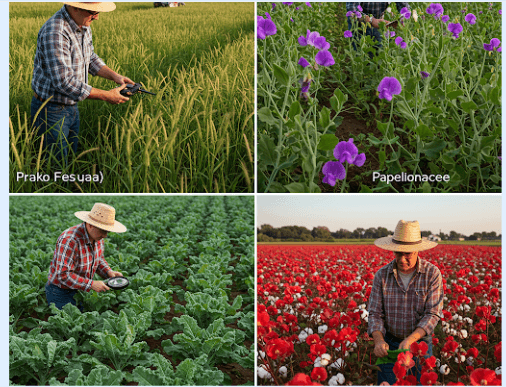Classification of Crops
(A) Taxonomic Classification of Crops

Poaceae (Graminae) or Grass family: Includes cereals, sugarcane, napier, and paragrass. This family is vital for food production as it includes staple crops like rice, wheat, maize, and other grains.
Papilionaceae (Leguminosae) or Pea family: Includes pulses, legumes, groundnut, and sunnhemp. Legumes are important for their nitrogen-fixing ability, enriching soil fertility.
Cruciferae/Mustard Family: Includes mustard, radish, cabbage, cauliflower, and knolkhol. These crops are typically cool-season crops, important for both food and oil production.
Cucurbitaceae/Gourd family: Includes gourds like bottle gourd, bitter gourd, cucumber, and pumpkin. These are commonly grown vegetables with high water content.
Malvaceae/Cotton Family: Includes cotton, bhindi (okra), and roselle. Cotton is a significant cash crop for textiles, and bhindi is an essential vegetable in tropical regions.
Solanaceae/Brinjal family: Includes brinjal (eggplant), potato, tomato, tobacco, and chillies. These crops are widely cultivated and essential for global cuisine and industrial uses.
Tiliaceae: Includes jute and phalsa. Jute is a major fiber crop used in making ropes, bags, and other textiles.
Asteraceae (Compositeae): Includes sunflower, safflower, and niger. These are oilseed crops that are also used for bird feed and in ornamental landscaping.
Chenopodiaceae: Includes spinach, beet, and sugar beet. These crops are grown for their edible leaves and roots.
Pedaliaceae: Includes sesame (sesamum), a major oilseed crop.
Euphorbiaceae: Includes castor and tapioca. Castor oil has industrial uses, while tapioca (cassava) is an important root crop.
Convolvulaceae: Includes sweet potato, a nutritious root crop rich in vitamins and minerals.
Umbelliferae: Includes coriander, cumin, and carrot. These crops are aromatic spices and root vegetables used worldwide.
Aliaceae: Includes onion and garlic, which are crucial for culinary use and have medicinal properties.
Zingiberaceae: Includes ginger and turmeric. Both crops are valued for their culinary and medicinal uses.
(B) Special Classification of Crops
Arable Crops: Crops that require preparatory tillage before planting, such as potato, tobacco, rice, sugarcane, and maize. These crops are usually cultivated in well-prepared, plowed soil.
Alley Crops: Arable crops grown in alleys formed by trees or shrubs. These crops help enhance soil fertility and reduce soil erosion. Examples include sweet potato, urd, turmeric, and ginger grown in passages formed by eucalyptus or cassia trees.
Augmenting Crops: Crops sown to supplement the yield of the main crop. For example, Japanese mustard with Berseem or Chinese cabbage with mustard to increase first-cut yield.
Avenue Crops: Crops grown along farm roads and fences, such as arhar (pigeon pea), glyricidia, and sisal.
Border Crops/Barrier/Guard Crops: Crops used to protect other crops from animal trespass or wind damage. Examples include safflower (thorny oilseed) planted around fields of chickpea.
Brake Crops: Crops planted to break the continuity of harmful biotic agents like pests or soil-borne pathogens in agro-ecosystems, such as legumes in a rice-wheat rotation.
Cash Crops: Crops grown primarily for sale and monetary gain, such as jute, cotton, tobacco, and sugarcane. These crops are significant in the agricultural economy.
Catch/Contingent/Emergency Crops: Crops planted when the main crop fails, typically fast-growing, short-duration crops like green gram, urd, cowpea, and onion.
Cleaning Crop: Crops whose agronomic practices help clean the field, such as potato or maize, which help eliminate weeds.
Cole Crops: Cold-weather crops from the cruciferae family, like cabbage, cauliflower, and Brussels sprouts, which are frost-tolerant.
Contour Crops: Crops planted along contour lines to prevent soil erosion, such as marvel grass.
Commercial Crops: Crops grown to earn money, such as jute, cotton, tobacco, and sugarcane. These crops are a subset of cash crops.
Cover Crops: Crops that protect the soil surface from erosion through dense foliage or root mats, e.g., lobia, groundnut, urd, and sweet potato.
Complementary Crops: Crops that benefit each other in intercropping systems, such as jowar with lobia, where jowar provides structural support and lobia fixes nitrogen.
Competitive Crops: Crops that compete with each other and are not suitable for intercropping, such as two cereals grown together.
Supplementary Crops: Crops that neither compete nor complement each other, like maize with cucurbits.
Exhaustive Crops: Crops that deplete soil nutrients significantly after cultivation, e.g., cereals.
Energy Crops: Crops grown to produce liquid energy sources, such as ethanol or alcohol. Examples include sugarcane, potato, maize, and tapioca.
Fouling Crops: Crops that lead to intense weed infestation due to their cultural practices, such as direct-seeded upland rice.
Ley Crops: Crops grown for grazing or harvested for livestock feed, such as berseem and mustard, used in ley cropping systems.
Mulch Crops: Crops grown to conserve soil moisture by acting as ground cover, e.g., cowpea.
Nurse Crops: Crops that help nourish other crops by providing shade or acting as climbing supports, such as rai in peas or jowar in cowpea.
Paira/Utera Crops: Crops planted a few days or weeks before harvesting the main crop, e.g., lathyrus in rice. This is also a form of relay cropping.
Paired Row Cropping: A system where every third row is removed, often used in dryland farming to conserve soil moisture.
Restorative Crops: Crops that help restore soil fertility and improve soil health, such as legumes that fix nitrogen.
Riparian Crops: Crops grown along irrigation or drainage channels, such as waterbind weed or para grass, which help prevent soil erosion.
Skip Cropping: A system where a line is left unsown in the regular row series, which can be used for moisture conservation or to manage soil fertility.
Silage Crops: Crops grown to be preserved in pits for animal feed, such as cowpea or jowar.
Smother Crops: Crops that suppress weed growth by covering the soil with dense foliage, such as cowpea and mustard.
Soiling Crops: Crops harvested while still green and fed fresh to livestock, like berseem and napier grass.
Trap/Decoy Crops: Crops used to attract and trap harmful pests or parasitic weeds, such as cotton red bugs trapped by bhindi or parasitic weeds trapped by solanaceous plants.
Truck Crops: Crops grown for direct sale in fresh markets, such as bhindi (okra) and spinach.
Ware Crops: Crops grown for temporary storage in warehouses for future use or sale, such as potatoes.

